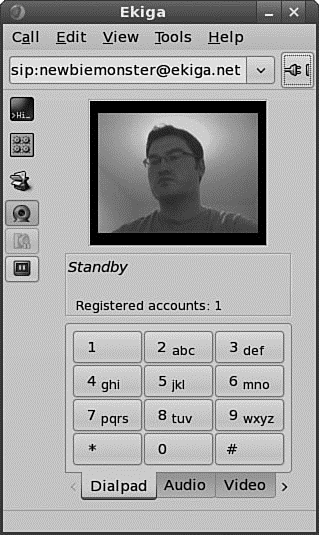Книга: Fedora™ Unleashed, 2008 edition
Videoconferencing with Ekiga
Videoconferencing with Ekiga
Ekiga is an Internet videoconferencing application that provides two-way voice and picture transmission over the Internet by using the H.323 protocol for IP telephony (also known as Voice over IP [VoIP]). It is an application similar to Microsoft NetMeeting and is provided with Fedora as the default videoconferencing client.
Before you can take full advantage of the phone and videoconferencing capabilities of Ekiga, you must configure a full-duplex-capable sound card and video device (see Chapter 7, "Multimedia") and a camera.
Ekiga is found in the Internet menu as Videoconferencing; you click the icon to launch it. When you start the Ekiga application for the first time, a configuration wizard (called a druid) runs and you are greeted by the first of four configuration screens. You simply enter your name, email address, and location and select your connection type. The settings for your audio and video devices are automatically detected; you can view them by selecting the Preferences item from the Edit menu. Figure 5.17 shows Ekiga in action, ready to dial another user.

FIGURE 5.17 Ekiga is surprisingly simple to use. A video source is not necessary; a static picture can be used, too.
When you have Ekiga running, you must register (from within Ekiga) with the server at http://ekiga.net/ to enable conferencing; Ekiga does this automatically for you if you told it to do so during the initial configuration.
You can find an informative FAQ at the Ekiga home page at http://www.Ekiga.org/ that you should read in full before using Ekiga. Also, an excellent article about VoIP is at http://freshmeat.net/articles/view/430/.
NOTE
If you frequently use VoIP applications such as Ekiga, you will tire of repetitively typing in long IP addresses to make connections. To avoid this hassle, you can use a gatekeeper — similar in purpose to a DNS server — to translate names into IP addresses. OpenH323 Gatekeeper is one such popular gatekeeper application. It is not provided with Fedora, but you can obtain it fromhttp://www.gnugk.org/.
- Using Double Quotes to Resolve Variables in Strings with Embedded Spaces
- Drawbacks with restore
- 7. AGGREGATION WITH INDEPENDENT WORKS
- Конструкция with-do
- 3. Hexadecimal – the way we communicate with micros
- CHAPTER 3 Working with GNOME
- CHAPTER 8 Printing with Fedora
- CHAPTER 15 Remote Access with SSH
- CHAPTER 20 Remote File Serving with FTP
- Managing Files with the Shell
- Working with Compressed Files
- Work with Shared Data in the




